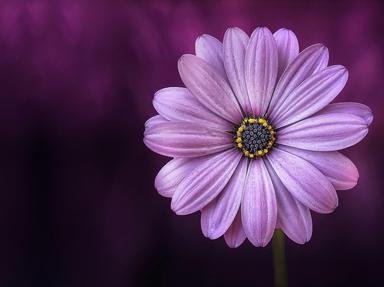Quiz Answer Key and Fun Facts
1. While it sounds rather ominous, what is the purpose of "deadheading" a flower?
2. The life of a garden plant is fraught with danger, and many plants do not live long enough to flower. Of the following which is NOT considered a likely reason for your plant to have died prematurely?
3. Who doesn't love the splay of color that marks the turning of a leaf from a healthy green to a red or yellow before the leaf falls away (and dies)? Without turning this into a science class, what chemical process in a plant decreases in the fall to produce a change in leaf color?
4. I am just starting my first garden here in Michigan and have planted a flat of lovely petunias in a sunny area. I tend to their every need and yet by the middle of next summer my poor petunias have withered to brown rot. What did I do wrong to have my petunias die so completely?
5. I get sad every time it snows because that means none of my garden flowers will grow, and there is no color in my garden. But aren't there, after all, some plants that flower in the depths of a snowy winter?
6. While flowers on a plant are beautiful, they serve a particular purpose in the plant's life cycle by aiding in the dispersal of pollen and assuring the production of new seeds. What is the term called when an insect (such as a bee) transfers pollen from one plant to another?
7. You are in a beautiful garden with some exotic plants and flowers including the lovely giant titan arums. At the same time you smell the distinct scent of rotting flesh but cannot find anything in decay. What is the term for a plant that emits a rotting flesh scent?
8. Any good gardener wants to keep weeds out of their garden. However, sometimes it's difficult to tell what is or isn't a weed. Which of the following is NOT generally a characteristic of weeds?
9. You love to garden and enjoy growing and eating healthy vegetables. Rabbits (and other animals) also enjoy eating your garden, leaving you with more dead plants than produce. You have tried everything you can to discourage Bugs and his friends, short of hiring Elmer Fudd, when a friend suggests planting a decoy garden. What is a decoy garden?
10. One growing trend in gardening is to try and reduce the water usage in keeping the garden healthy and colorful. A modern term for a garden that reduces grass and high water consuming plants is a compound of the Greek word for dry and the word for a scene or scenery. What is this eco-friendly term?
Source: Author
adam36
This quiz was reviewed by FunTrivia editor
WesleyCrusher before going online.
Any errors found in FunTrivia content are routinely corrected through our feedback system.

